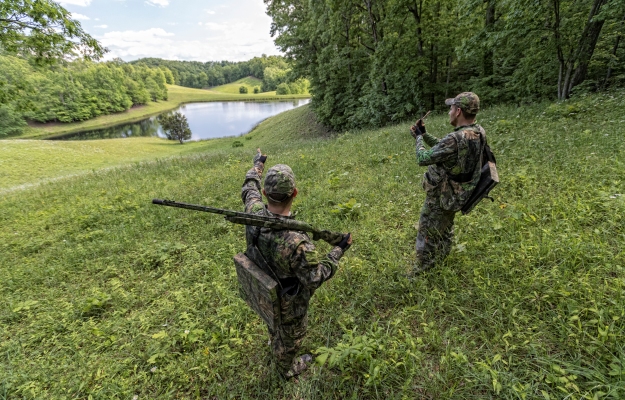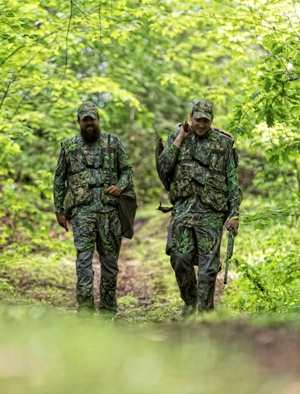
I've got quite a few grandchildren, and we start hunting together when all of them are youngsters. I feel like I have a moral obligation to take my grandkids turkey hunting each season. Although I’ve hunted with some famous people over the years, those grandchildren turkey hunts are always the most memorable hunts of every season.
I took my grandson Blake hunting this past season. As a youngster, Blake had a lot of nervous energy and even today loves to run-and-gun turkey hunt. He doesn’t enjoy sitting in a blind. Given the option, even if a turkey’s coming, he prefers to sit outside a blind. However, on our hunt in 2017, he had to change his mind.
I have a blind set up on top of a ridge here in Kentucky, and I’ve hunted this place so long that I know that the turkeys like to travel across the top of the ridge or along the side of the ridge every season. We saw the blind when we first got to the woods, and I suggested that we get into it. I felt sure Blake would bag a turkey if he sat in the blind.
But of course Blake said, “No sir, I don’t want to hunt out of a blind.”
I told him, “Okay, we’ll just move through the woods and call.”
However, before we left that spot, I gave a cutting call and a gobbler answered. The turkey was about 150 yards on the opposite side of that blind from the spot where I had called.
I whispered, “Blake, this is a first-class opportunity for you to get in that blind. Then you’ll be able to see the turkey coming in from a long way off and bag that bird.”
 We hadn’t brought any decoys with us, so Blake agreed with me to get in the blind. Where the blind sits, there are open hardwoods on both the tops and the sides of the ridge. Even sitting while wearing the finest Mossy Oak patterns ever made, a turkey will spot you, either as you’re going to him, or he’s coming to you. So, we got in the blind. The next time that turkey gobbled - he wasn’t 100 yards from us. I’d already written out a script in my head which way the turkey should come from, where the turkey would end up, and where Blake could shoot him.
We hadn’t brought any decoys with us, so Blake agreed with me to get in the blind. Where the blind sits, there are open hardwoods on both the tops and the sides of the ridge. Even sitting while wearing the finest Mossy Oak patterns ever made, a turkey will spot you, either as you’re going to him, or he’s coming to you. So, we got in the blind. The next time that turkey gobbled - he wasn’t 100 yards from us. I’d already written out a script in my head which way the turkey should come from, where the turkey would end up, and where Blake could shoot him.
This turkey didn’t read my script. In just a few minutes, a hen walked out in front of the blind and started scratching in the leaves for something to eat. Finally, that hen walked past the blind, and the gobbler never did come. I looked behind the blind and saw that gobbler in full strut to the left of the blind.
So I told Blake, “We’re in a perfect position for you to kill that turkey, but you’re going to have to unzip that side window, put your gun out the window, take your time and aim carefully. I’ll call to get the gobbler to stick his head up, and you shoot him.”
Well, every time I’d call, the turkey would gobble and stay in the strut. But finally that gobbler stuck his head up really high to try and see the hen he’d been talking to and Blake shot. However, he shot over the top of the turkey’s head. At the report of the shotgun, the turkey ran straight at Blake in the blind and stopped 15 yards from the blind. Blake was able to take him.
We not only had a great hunt, but we also made a great family memory. Turkeys are really easy to miss, especially with the accuracy of today’s modern shotguns and the types of turkey chokes that most people use. These guns throw a very tight pattern, and if the turkey ducks or moves his head even a little, you may miss him.
Day 3: Harold Knight Likes to Hunt Home Turkeys
Tomorrow: Building Memories is the Best Part of Turkey Hunting



























